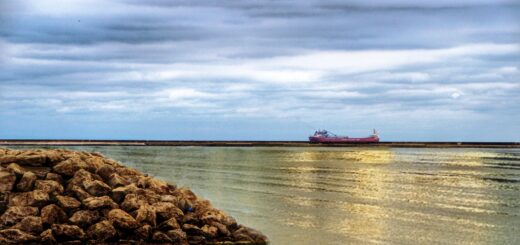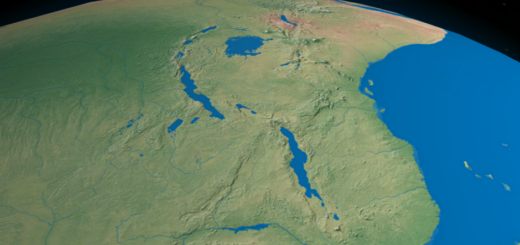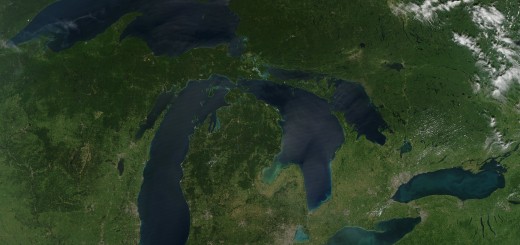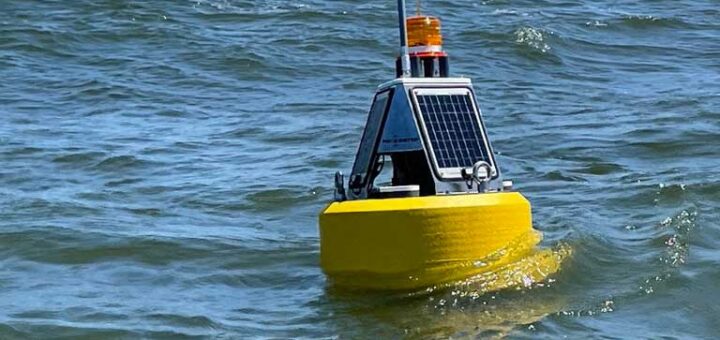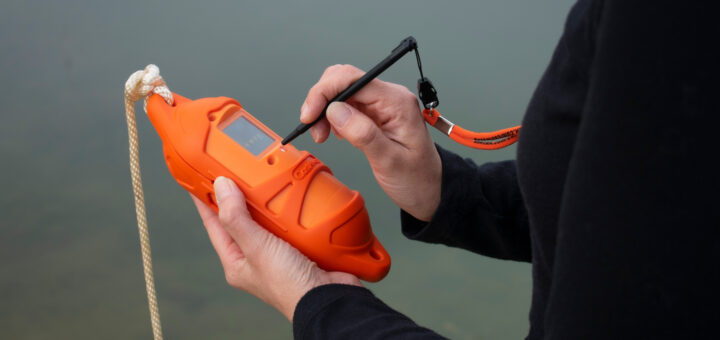Research Summary: Shading as a Control Method For Invasive European Frogbit
0European frogbit (Hydrocharis morsus-ranae L.) is an invasive floating plant in North American water bodies. The species escaped in 1939 from a Botanical Garden in Ottawa, Canada and had reached the United States by 1974. Studies have shown that light is essential for the germination and growth of European frogbit, that light-deprivation may reduce frogbit root growth by 90%. It follows that control methods utilizing shading are likely to inhibit the growth and spread of this invasive species. Shading has already been successfully used for controlling aquatic plants such as submerged cabomba. It was reported that the 99% shade completely removed cabomba within four months and the 70% shade was effective at deeper depths. However, shading may have negative impacts on beneficial submerged plants that grow underneath target species due to further reductions in the amount of light penetrating to deeper depths. A desirable outcome should result in the effective control of European frogbit and minor or no impacts on submerged macrophytes below. Consequently, the objectives of this study are: to test the efficacy of different levels of shading as controls on European frogbit growth in both greenhouse and lake mesocosm experiments; and to assess the impacts of the shading method on aquatic ecosystems by examining temperature, dissolved oxygen, and submerged macrophytes underneath treated European frogbit mats.
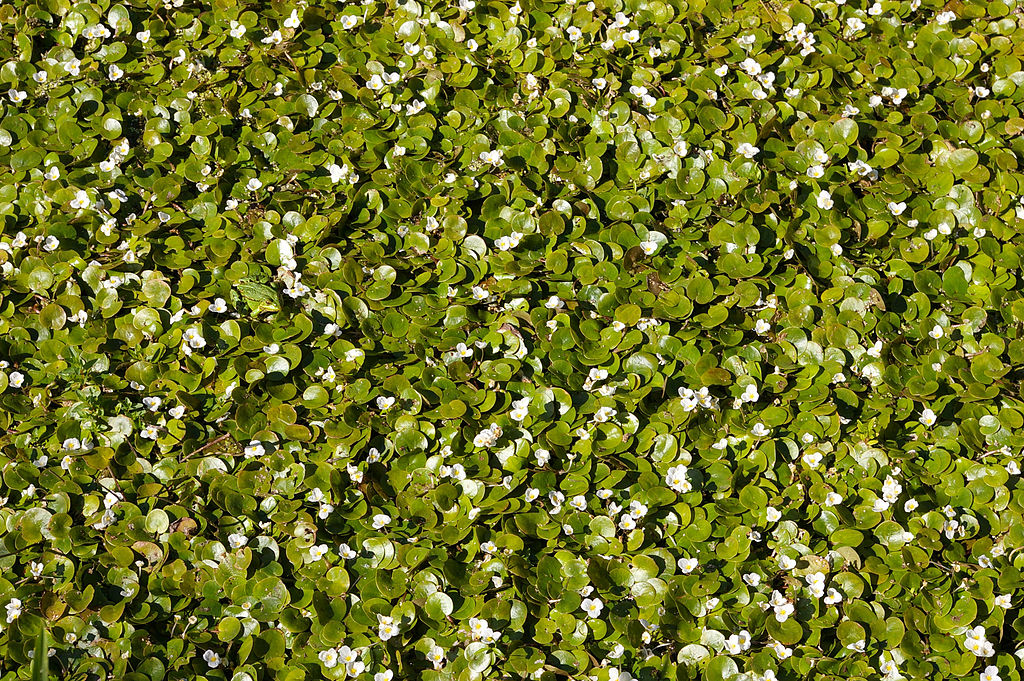
European Frogbit. (Credit: Christian Fischer via Wikimedia Commons)
Methods
This study investigated shading as a control method for European frogbit in both greenhouse and lake mesocosm experiments. A series of shade treatments (0%, 50%, 60%, 70%, 80%, and 100%) were tested in the greenhouse for three weeks. Individual, full-grown plantlets were put in 5-gallon white buckets with different shade cloths, and all plantlets were similar in size at the beginning of the experiment. European frogbit growth was evaluated by the number of plantlets in each bucket, the average biomass per plantlet, and total biomass at the end of the experiment. Additionally, a lake mesocosm experiment utilizing 0% shade, 70% shade, and 100% shade treatments was performed in a sheltered inlet of Oneida Lake in New York State for over one month. Total biomass of European frogbit was collected and measured at the end of the experiment to test the effectiveness of the shade method. Submerged aquatic macrophytes were collected at the beginning and the end of this experiment to evaluate the impacts of the shade method on submerged macrophytes.
Results
The greenhouse experiment showed that the 100% shade was most effective at controlling European frogbit, and other shade treatments greater than 50% were less effective, reducing frogbit biomass up to 38.2%. There were no differences found in temperature between treatments, but dissolved oxygen decreased as shading increased. In the lake mesocosm experiment, resulting European frogbit biomass was significantly (25 times) less in areas treated with the 70% shade and nearly zero with the 100% shade. Shading did not affect temperature but improved DO conditions. Results on the shading effects on submerged macrophytes were not conclusive: no significant differences in changes in species richness and abundance between the three groups at the end of the studied period suggested no shading effects; significant differences between the beginning and end communities in the 70% shade and the 100% shade, but not in the control group, indicated significant impacts of shading.
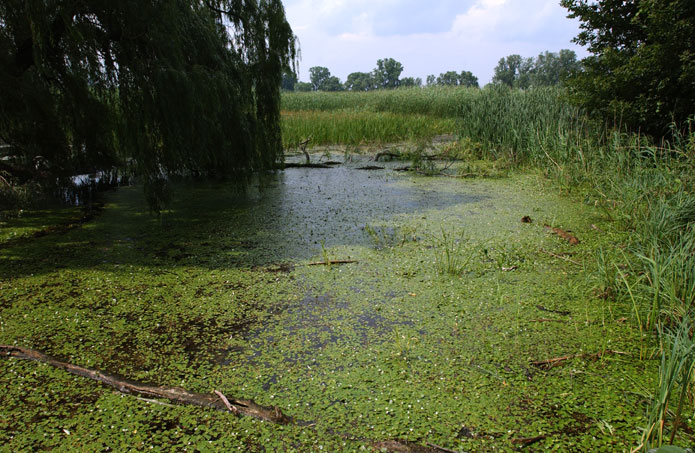
Invasive Frogbit inhabits a pond in Michigan. (Credit: Michigan Sea Grant)
Discussion
Our results from both greenhouse and lake experiments revealed that the 100% shade was most effective at removing invasive European frogbit. However this level of shading should be considered unacceptable as a large-scale control option since its application significantly reduces native plant growth and would be detrimental to many other aquatic organisms. A moderately high density of shade, such as 70%, did effectively control invasive European frogbit and could be a control option. In our lake mesocosm experiment, the 70% shade significantly reduced frogbit biomass by 25 times over the course of a one-month trial, while in the greenhouse experiment, shade treatments greater than 50% were all relatively effective in the control of European frogbit, especially in reducing frogbit biomass. This study is the first one to investigate shading as a control method for European frogbit and it is concluded that a moderately high density shade can effectively remove European frogbit likely with minor impacts on the environment. It is also recommended that more experiments with larger scales and longer time periods be undertaken for further investigation.
Full study published by Zhu B, Ellis MS, Fancher KL, and Rudstam LG. 2014. Shading as a Control Method for Invasive European Frogbit (Hydrocharis morsus-ranae L.). PLoS ONE 9(6): e98488. doi:10.1371/journal.pone.0098488.
Selected References
- Catling PM, Miltrow G, Haber E, Posluszny U, Charlton WA (2003) The biology of Canadian weeds. 124. Hydrocharis morsus-ranae L. Can J Plant Sci 83:1001-1016.
- Catling PM, Spicer KW, Lefkovitch LP (1988) Effects of the floating Hydrocharis morsus-ranae (Hydrocharitaceae), on some North American aquatic macrophytes. Nat Can 115:131-137.
- Hudon C, Lalonde S, Gagnon P (2000) Ranking the effects of site exposure, plant growth form, water depth, and transparency on aquatic plant biomass. Can J Fish Aquat Sci 57(Suppl.1):31-42.
- Miller JD, Haller WT, Glenn MS. 1993. Turion production by dioecious hydrilla in North Florida. J Aquat Plant Manage 31:101-105.
- Minshall WH (1959) Effect of light on the extension growth of roots of frog- bit. Can J Bot 37:1134-1136.
- Reed DC, Foster MS (1984) The effects of canopy shading on algal recruitment and growth in a giant kelp forest. Ecology 65:937-948.
- Roberts ML,Stuckey RL, Mitchell RS (1981) Hydrocharis morsus-ranae (Hydrocharitaceae): new to the United States. Rhodora 83:147-148.
- Schooler SS (2008) Shade as a management tool for the invasive submerged macrophyte, Cabomba caroliniana. J Aquat Plant Manage46:168-171.
- Zhu B, Eppers ME, Rudstam LG (2008) Predicting invasion of European frogbit in the Finger Lakes of New York. J Aquat Plant Manage 46:186-189.
- Zhu B, Fitzgerald DG, Mayer CM, Rudstam LG, Mills EL (2006) Alteration of ecosystem function by zebra mussels in Oneida Lake, NY: impacts on submerged macrophytes. Ecosystems 9:1017-1028.





